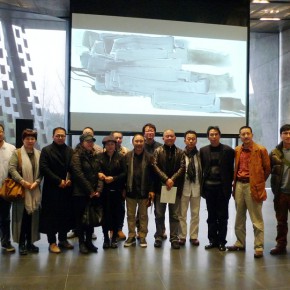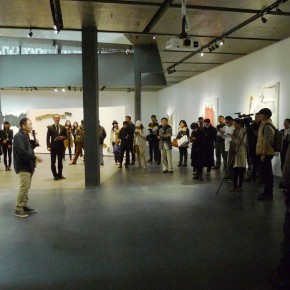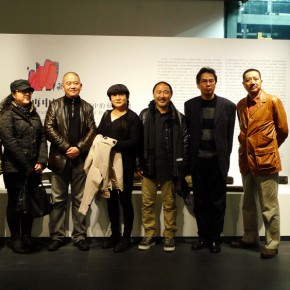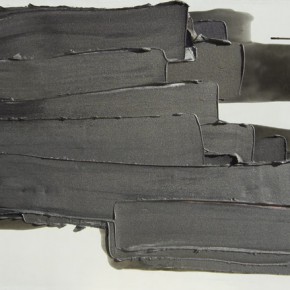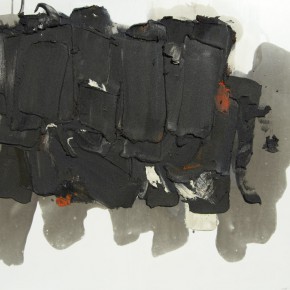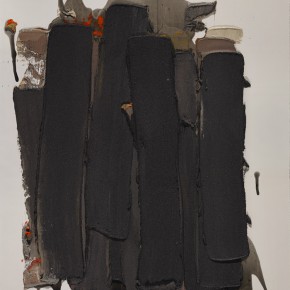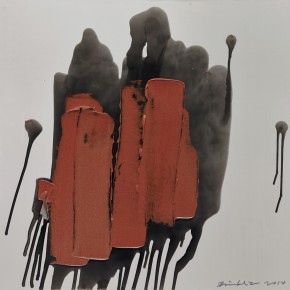
Hosted by Zhi Art Museum, organized by Qiertang Club and Huayangnian Group (China), planned by Wu Xiaoyan, “Burigude in the Process of Resinicization” opened on November 29, and the exhibition showcases 30 abstract paintings endowed with an Oriental connotation which were created by the artist Burigude Zhang in recent years. At the same time, it also launched a discussion for the exhibition, presided over by art critic Ji Shaofeng that day.
Burigude Zhang is an artist born in Inner Mongolia, he accepted a formal education from CAFA, majored in Comic Books in the 1980s, designed artwork for comic books after his graduation, and his creation was influenced by the times, performing using ink and realistic techniques, and focused on the combination of his feelings to perform the Mongolian amorous feelings.
In the 1990s, because of his yearning for Western modern and contemporary art, and the desire to search for a new opportunity for creation, Burigude visited England, where he studied painting and printmaking in Bradford College, England. He writes in the self-statement that, the reason why he often uses black and white acrylic colors and the enlarged horizontal and vertical brushworks to convey the freehand Chinese feelings since 2008, as he had very strong feelings towards Chinese traditional culture as well as employing in-depth research, there are also several external reasons: firstly, his teacher Ian Colverson appreciated his method of using a big brush to draw the body, so he became more and more in love with the carefree, frank and direct way of painting. Consequently the objective element of the shaping gradually disappears. There is no doubt that this new direction is obviously enlightened by Western abstract painting; secondly, when he tried to use a big brush to draw the human body, he seriously researched the painting style of the British painter Bacon, who used a brush to paint people and beasts, in addition, he also studied the American artist DE Kooning’s pornographic and diastolic brush strokes, which also greatly helped his later paintings; thirdly, when he was a postgraduate student, his printmaking creation mainly used cheaper aluminum plate for printing instead of expensive copper plate, and gave up the traditional engraving and drawing style. In using the technique of pasting material, he initially writes and paints in latex, and then sprinkles on a layer of silicon carbide. In fact, it is converted to the current painting style by mixing acrylic with quartz sand. The unique method of using a shovel to paint makes his painting have the same effect as bas-relief.
Why does the artist Burigude usea Western painting medium while striving to go beyond the schema system of Western abstract painting, to develop the new art symbol with a traditional calligraphic connotation? In addition, why doesn’t he use a traditional brush, paper and ink to merge the Western abstract art experience with his creation? In terms of the former, on the one hand he connects with the traditional blood relations; on the other hand he hopes to find a method of performance that conforms his mind. In terms of the latter, starting from the psychology found in the visual feelings of modern people, he perhaps instinctively feels for the traditional brush, paper and ink which seem weak in overseas exhibitions. Compared with this, the new medium that he chose is not only more expressive, but also leads to a larger development space. Fortunately, he finally reaches his target. After changing from traditional calligraphy, brush and ink to using concise straight lines, and horizontal lines, it tends to be more abstract and modern and when worked together offers a strong visual impact.
About the exhibition
Duration: November 29, 2014 - January 29, 2015
Venue: Zhi Art Museum
Curator: Wu Xiaoyan
Academic Director: LuHong
Host: Zhi Art Museum
Organizers: Qiertang Club, Huayangnian Group (China) Co., Ltd.
Translated by Chen Peihua and edited by Sue/CAFA ART INFO
Courtesy of the artist and Zhi Art Museum.


